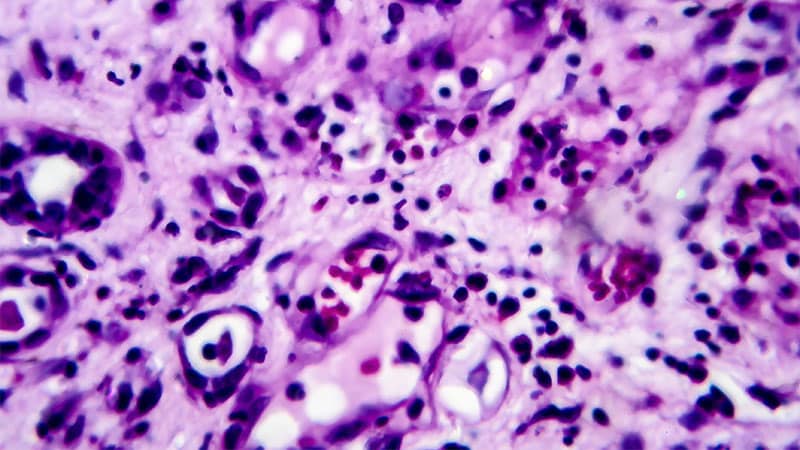Core Concepts
Urine biomarker CXCL9 is a crucial diagnostic tool for acute tubulointerstitial nephritis (AIN), offering a faster and easier alternative to kidney biopsies.
Abstract
The content discusses the significance of the urine biomarker CXCL9 in diagnosing acute tubulointerstitial nephritis (AIN) as an alternative to kidney biopsies. Here is a breakdown of the key points:
AIN Diagnosis Challenge:
AIN is challenging to diagnose due to a lack of specific signs or symptoms.
Current diagnostic tests have poor accuracy, leading to the need for kidney biopsies.
Role of CXCL9 Biomarker:
CXCL9 levels in urine significantly increase in patients with AIN.
Urinary CXCL9 levels are higher in AIN patients compared to those without AIN.
CXCL9, along with TNF-α and IL-9, is considered an optimal biomarker combination for AIN diagnosis.
Clinical Implications:
CXCL9 can help differentiate AIN from other conditions like acute tubular injury.
The development of assays for detecting CXCL9 in urine samples may aid in prognosticating clinical outcomes.
Authors' Contribution:
Authors suggest CXCL9, TNF-α, and IL-9 as key biomarkers for AIN diagnosis.
Authors are involved in a pending patent for a new CXCL9 assay and are founders of Predict AIN.
Urine Test Biomarker Allows Diagnosis Without Kidney Biopsy
Stats
"Levels of urinary CXCL9 were 7.6-fold higher in patients with AIN compared to those without AIN."
"The adjusted odds ratio was 6.0 for the highest versus lowest quartiles of CXCL9."
"CXCL9 mRNA expression was 3.9-fold higher in kidney tissue from patients with AIN compared to the control group."
Quotes
"Our data show that in patients with suspected AIN the urine biomarker CXCL9 can significantly improve clinical care by helping to rule in or rule out the disease in a large subset of patients." - Authors
Key Insights Distilled From
by Nancy A. Mel... at www.medscape.com 07-31-2023
https://www.medscape.com/viewarticle/994979
Deeper Inquiries
How can the integration of CXCL9 biomarker testing impact the overall management of AIN patients?
The integration of CXCL9 biomarker testing can significantly impact the overall management of AIN patients by providing a non-invasive and efficient method for diagnosing the condition. By utilizing CXCL9 levels in urine samples, clinicians can quickly rule in or rule out AIN in a large subset of patients, reducing the need for invasive kidney biopsies. This streamlined diagnostic process can lead to earlier identification of AIN, allowing for prompt withdrawal of offending medications and initiation of corticosteroid therapy, which are crucial steps in preventing acute kidney injury (AKI). Additionally, the use of CXCL9 biomarker testing can help differentiate AIN from other causes of AKI, leading to more targeted and effective treatment strategies for patients.
What potential challenges or limitations might arise in the widespread adoption of CXCL9 as a diagnostic tool for AIN?
Despite its potential benefits, there are several challenges and limitations that may arise in the widespread adoption of CXCL9 as a diagnostic tool for AIN. One challenge is the need for validation and standardization of CXCL9 assays to ensure accuracy and reliability across different healthcare settings. Additionally, the cost of implementing CXCL9 testing on a large scale may pose a barrier to widespread adoption, especially in resource-limited settings. Furthermore, there may be variability in CXCL9 levels due to factors such as age, sex, and comorbidities, which could impact the interpretation of test results. Lastly, healthcare providers may require training and education on the use of CXCL9 biomarker testing, which could slow down the integration of this diagnostic tool into clinical practice.
How can the development of new biomarker assays like CXCL9 in urine samples revolutionize diagnostic practices in other medical conditions?
The development of new biomarker assays like CXCL9 in urine samples has the potential to revolutionize diagnostic practices in other medical conditions by offering non-invasive, rapid, and accurate diagnostic tools. These biomarkers can provide valuable information about disease processes, prognosis, and treatment response, leading to more personalized and targeted healthcare interventions. By utilizing biomarker assays, healthcare providers can make informed decisions about patient care, monitor disease progression, and adjust treatment plans accordingly. Furthermore, biomarker testing can help identify high-risk patients, stratify disease severity, and improve overall clinical outcomes. As technology advances and more biomarkers are discovered, the landscape of diagnostic medicine is likely to be transformed, offering new possibilities for early detection and management of various medical conditions.
0
